Why the sound icon disappeared. The sound icon is missing, what should I do?
It is known that operating system Windows has many flaws. One of them is changing the interface without the user's knowledge. This is not at all about global changes, but rather about details. For example, frequent problem is the disappearance of the volume icon. Let's consider this problem in more detail and answer how to restore the volume icon.
Basic ways to restore the volume icon
Usually the volume icon is located in the tray. But if you are not satisfied with this location, then you can click on the arrow button in the lower right corner and then select the "Configure" link.
- Now you need to pay attention to the "Behavior" section in a new window, there you can select the "Show icon and notifications" line. Make sure the volume is turned on, then click the OK button.
- You can use another method. Go through the Start menu to Control Panel, select "Notification Area Icons". In the volume parameter, select "Show icon" and "Notifications", press OK.
Using Microsoft Assistant
If you have lost the volume icon and you do not know what to do, do not despair. After all, Microsoft produces many utilities for fixing problems. These include special utility called Fix it.
Run this utility and accept all terms and conditions. Then click the Next button. The assistant should automatically adjust the settings so that the icon appears on the taskbar in the right corner.
Registry changes
This method is rather laborious. But it does help bring back the volume icon. You need to go to the Start menu and select Run.
- Then enter the command and go to the registry editor, go to the following path:
HKEY_CURRENT_USER \ Software \ Classes \ LocalSettings \ Software \ Microsoft \ Windows \ CurrentVersion \ TrayNotify. - Then find the line IconStreams on the right side of the window. Remove it by clicking right click mice.
- Delete the post PasticonsStream.
- Now you need to invoke the "Task Manager" by pressing crtl + alt + delete. After that, you will be taken to the dispatcher window, where you need to find the explorer.exe process. This explorer must be closed by clicking "End Process". Now in the task manager select "File" and assign a new task, write explorer.exe and press enter.
This way you can turn on the volume icon in Windows and continue working successfully.
The volume change icon provides easy access to a slider that allows you to quickly adjust this setting. You don't have to go to the control panel - everything is right at your fingertips. However, for some people, it may suddenly disappear, which causes some discomfort when using Windows. The reason for this may be malware and viruses, accidental user actions or system crashes. This guide will be useful for users who have disappeared from the taskbar speaker volume control icon.
By default, this item is located on the taskbar, which is called the tray. The tray is located at the very bottom of the screen to the left of the time and date. In it you can find small icons for calling various running programs and some system settings, in particular the volume control icon.
Restart Windows
The most common way to solve many problems in Windows is to restart your computer.
An operating system is a program that is very complex in its structure and constantly changes something inside itself. It is likely that it hung a little, as a result of which one of its elements ceased to function correctly. If something suddenly stops working - the first thing to do is to simply restart your PC.
Taskbar properties
It may be that one of the users accidentally disabled the display of the desired object, and it ceased to be active. To restore it, you need to go to the tray properties.
You are familiar with this situation: you turn on the computer, your favorite Windows operating system starts up, and you see that there is no volume control. The sound itself is there, but you cannot adjust it, since the volume icon is not displayed.
This is actually normal for Windows and the volume icon should be in place the next time you boot. But you definitely shouldn't restart your computer because of such a trifle!
P.S. By the fact that such a situation is the norm for Windows, it means that this happens quite often, and not that this fact is normal.
In most cases, the following steps help.
1) Check if the volume display is turned on.
For some unknown reason, this setting sometimes gets lost, and the volume display is turned off.
a) Right-click in free space in the tray area (next to the clock and language bar), and go to properties.
b) Or open the control panel, go to the “Notification area icons” (icon mode), and click on the link “Turn system icons on or off”.
Make sure the volume is turned on. If the volume is “Off”, turn it on by putting “On” and press Ok.
2) Restart Windows Explorer.
You can restart the explorer right away without completing the first step.
To restart Explorer, open the Task Manager (“ctrl + shift + Esc”) go to the “Processes” tab, find and end the “explorer.exe” process. Then click “File \ new task (execute ...)”, write explorer and click Ok.
After the above actions, the volume icon should return to its place.
Good hour everyone.
Recently one laptop was brought with a request to "fix" it. The complaints were simple: it was not possible to adjust the volume, since there was simply no sound icon in the tray (next to the clock). As the user said: "I didn't do anything, this badge just disappeared ..."... And maybe the thieves of sound have started? 🙂
As it turned out, it took about 5 minutes to solve the problem. I will set out my thoughts on what to do in the same situation in this article. (from the most common problems to the least common).
1) It's corny, but maybe the icon is just hidden?
If you have not configured the display of icons accordingly, then, by default, Windows hides them from view (although, usually, this does not happen with the sound icon). In any case, I recommend opening the tab and checking: sometimes it is displayed not next to the clock (as in the screenshot below), but in the special. tab (you can see hidden icons in it). Try to open it, see the screenshot below.

Show hidden icons in Windows 10.
2) Check the settings for displaying system icons.
This is the second thing I recommend to do with this problem. The fact is that you could not have set the settings yourself and hide the icons, and for example, Windows could be configured accordingly, after installing various tweakers, programs for working with sound, etc.
To check it - open control Panel and enable display as small icons.
If you have Windows 10 - open the link taskbar and navigation (screenshot below).
If you have Windows 7, 8- open the link notification area icons .
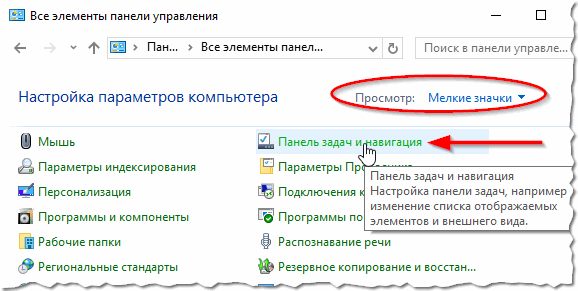
Windows 10 - All Control Panel Items
Below is a screenshot of what the setting for showing icons and notifications looks like in Windows 7. Here you can immediately find and check if the settings for hiding the sound icon are set.

Icons: network, power, volume in Windows 7, 8
In Windows 10, in the tab that opens, select the "Taskbar" section, and then click the "Configure" button (opposite the " Notification area".


After that, you will see all the system icons: here you need to find the volume and check if the icon is turned off. By the way, I also recommend turning it on and off. In some cases, this helps to solve the problem.
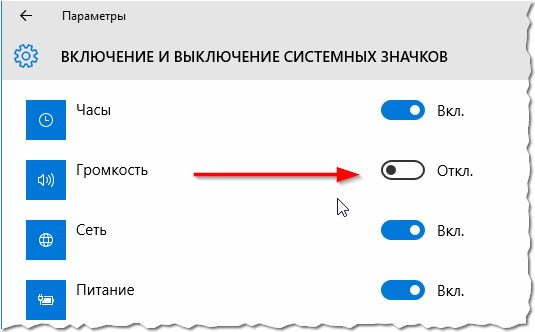
3. Trying to restart Explorer.
In some cases, a banal restart of the explorer helps to solve dozens of problems, including the incorrect display of some system icons.
How do I restart it?
1) Open the task manager: to do this, just hold down the combination of buttons Ctrl + Alt + Del or Ctrl + Shift + Esc.
2) In the manager, find the "Explorer" or "Explorer" process, right-click on it and press restart (screenshot below).
Another option: also find the explorer in the task manager, then simply close the process (at this moment you have a worker will be lost table, taskbar, etc. - don't be alarmed!). Then press the button " File / new task", write" explorer.exe "and press Enter.

4. Checking parameters in the editor group policy.
The Group Policy Editor can have a setting that will "remove" volume icon from the taskbar. To make sure if someone has set a similar parameter, I recommend checking it just in case.
How to open the Group Policy Editor
Press the buttons first Win + R- the "Run" window should appear (in Windows 7 - you can open the START menu), then enter the command gpedit.msc and press ENTER.

Then the editor itself has to open. In it, open the section " User Configuration / Administrative Templates / START Menu and Taskbar ".
If you have Windows 7: look for the parameter "Hide the volume control icon".
If you have Windows 8, 10: look for parameter "Remove volume control icon".
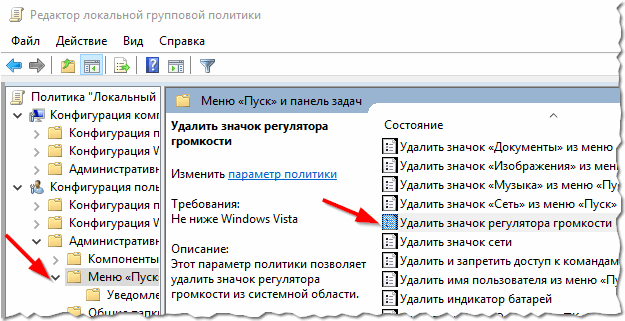
Local Group Policy Editor (clickable)
After opening the option, check to see if it is enabled. Maybe that's why you don't have a tray icon ?!
5. Special. program for advanced sound settings.
There are dozens of programs on the network for advanced sound settings (in Windows, after all, some points, by default, cannot be configured, everything looks rather stingy).
Moreover, such utilities can not only help with detailed sound control (for example, set hotkeys, change the icon, etc.), but also help restore the volume control.
One such program is Volume ?.
Website: https://irzyxa.wordpress.com/

The program is compatible with all Windows versions: XP, Vista, 7, 8, 10. It is an alternative volume control, with which you can accurately adjust the volume, customize the display of icons, change skins (covers), there is a task scheduler in the kit, etc.
6. Are the fixes installed from the Microsoft website?
If you have a rather "old" Windows OS that has not been updated for a long time, you may need to pay attention to a special update on the official Microsoft website.
Issue: System icons do not appear in the notification area in Windows Vista or Windows 7 until the computer restarts
Of. Microsoft website with a solution to the problem: https://support.microsoft.com/ru-ru/kb/945011
In order not to repeat myself, here I will describe in detail what Microsoft recommends I will not. Also pay attention to registry settings: the link above also has a recommendation for its configuration.
7. Try reinstalling the audio driver.
Sometimes, missing sound icon is related to audio drivers (for example, they were "crooked" installed, or not "native" drivers were installed at all, but from some "newfangled" collection that simultaneously installs Windows and configures drivers, etc.)
The last thing I can advise is to reinstall Windows, moreover, choose not a variety of collections from "craftsmen", but a normal one official version... I understand that this recommendation is not the most "convenient", but at least something ... If you have any advice on this issue, thank you in advance for your comment. Good luck! Social buttons:
WITH various problems the user collides with the constant work at the computer. Whether it is a laptop, computer or netbook - no difference. Today we will have a conversation about a very interesting situation that can be found at different Windows systems, namely when the volume icon disappeared.
What to do in such a situation? First of all, we restart the computer, usually this helps to return the volume icon to its place.
If, as the people say, it didn't work, then read on. Most commonplace, click on the tray tab and see if there is a volume control icon. If it is there, then we will configure its display on the taskbar.
Click on the tab and then select "Customize."
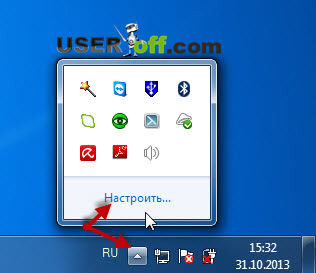
A new window will open in which you will find the same icon. Now set the Behavior column to Show Icon and Notifications.

Also just below this window, click Turn System Icons On or Off.

Make sure these settings are: Volume - On. If you have made any changes, click "OK".
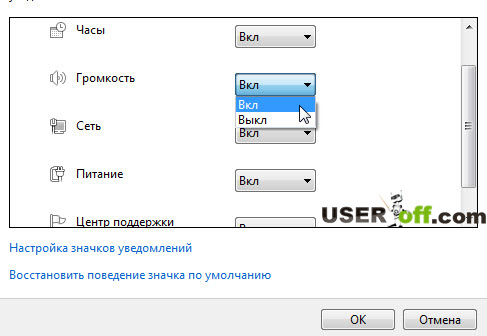
After which it should appear for you. You can also enter these settings in another way: "Start" - "Control Panel", set the view mode "Large icons" or "Small icons" (this is done in the upper right corner of the window). Then we find the item "Notification area icons".
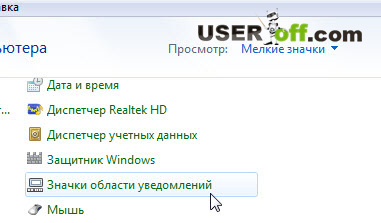
Here you are looking for "Volume" and put the option "Show icon and notifications" opposite it. Then we press "OK" and if nothing has changed, restart the computer, after which everything should appear.
Editing the registry
Above, I talked about the situation if your system is not configured as needed. Next, we will understand the problem itself.
For users who are with a computer on you - I consider this method the most difficult, but it guarantees the return of the volume icon to 100% (if you, of course, perform all the actions on your computer).
Missing volume icon? It doesn't matter, we have a registry that will help put the sound volume icon in its place. We go to "Start", select "Run" - enter regedit and press Enter. Then the Registry Editor opens. Now your attention is needed, do the following path: HKEY_CURRENT_USER \ Software \ Classes \
LocalSettings \ Software \ Microsoft \ Windows \ CurrentVersion \ TrayNotify. In the right part of the window, find IconStreams by right-clicking on the parameter, selecting "Delete" - "Yes". Then we do the same with the PastIconsStream.

Exit the registry and restart the explorer.exe process ("Explorer"). To do this, we have to open the "Windows Task Manager". This is done using the key combination "Ctrl" + "Shift" + "Esc", then go to the "Processes" tab. Find explorer.exe there, right-click on it and in the drop-down menu, boldly click "End Process". A message will appear, in which we also click on the button of the same name.
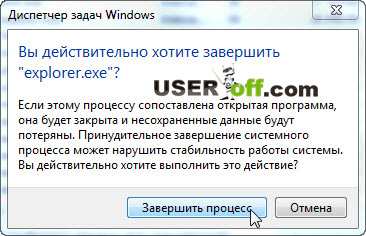
Do not be alarmed, everything will disappear from the desktop. It should be so.

Please note that you do not need to close the dispatcher window, and if you have closed it, we just start it again. Now go to "File" - "New task (Run ...)".

We type explorer.exe and press Enter. We are glad, because, firstly, all the desktop icons are back, and secondly, the volume icon reappeared on the taskbar, as if it had not disappeared anywhere.

If nothing appears (in theory, it should!), Restart your computer. This method should be used only as a last resort, when nothing else helps, because you need to do it carefully! The registry is not a toy, deleting the necessary parameters - the system may fail.
In this article, I have provided examples for Windows 7, but for those using Windows XP, there is a very detailed article from Microsoft. Link to article.
If you have done all the steps, but there is no result, then try restarting your computer after all the methods. Perhaps rebooting was missing Windows.
On this note, I conclude my article.
 Wireless Charging Smartphones A5 Supports Wireless Charging
Wireless Charging Smartphones A5 Supports Wireless Charging Why do not MTS sms come to the phone?
Why do not MTS sms come to the phone? Why do you need a full factory reset on Android or how to return Android to factory settings
Why do you need a full factory reset on Android or how to return Android to factory settings